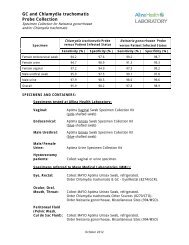Human (Granulocytic) Anaplasmosis (HGA ... - Allina Health
Human (Granulocytic) Anaplasmosis (HGA ... - Allina Health
Human (Granulocytic) Anaplasmosis (HGA ... - Allina Health
Create successful ePaper yourself
Turn your PDF publications into a flip-book with our unique Google optimized e-Paper software.
In 2010, there were 720 reported confirmed or probable cases of <strong>HGA</strong> in Minnesota (16.9<br />
cases per 100,000 population), more than twice the number reported in 2009. 59% were in<br />
males, the median age was 57 years, and the majority of cases were reported in May-July,<br />
with a peak in June. 27% of patients were hospitalized (1-42 days) and there was one<br />
reported death. 5% of <strong>HGA</strong> cases also had Lyme disease, and 1% also had confirmed or<br />
probable babesiosis. The frequency of co-infection may be underestimated.<br />
A disease related to <strong>HGA</strong>, called <strong>Human</strong> Monocytic Ehrlichiosis, is caused by Ehrlichia<br />
chaffeensis. It is uncommon in Minnesota. It is found throughout much of the southeastern<br />
and southcentral United States and is carried mainly by the Lone Star tick. However, a few<br />
cases of Ehrlichia muris-like agent-related disease, carried by I. scapularis, have been reported<br />
in Minnesota and Wisconsin since 2009. Ehrlichia ewingii, the agent of canine granulocytic<br />
ehrlichiosis, may occasionally cause an ehrlichia-like illness in humans.<br />
Anaplasma phagocytophilum (formerly known as Ehrlichia phagocytophilum) is the agent of<br />
<strong>HGA</strong>. It has tropism for neutrophils (whereas E. chaffeensis has tropism for monocytes). The<br />
incubation period is typically 7-10 days before development of overt symptoms, although onset<br />
of illness may be 5-21 days after exposure. Disease transmission is usually from tick bite,<br />
although other reported routes include blood inhalation/percutaneous blood exposure<br />
following butchering of white-tailed deer, blood transfusion, and transplacental infection. Many<br />
infections go undiagnosed because of the mild nonspecific symptomatology associated with<br />
the majority of infections.<br />
Symptoms typically include chills, fever, headache, myalgias and arthralgias. Less common<br />
symptoms include nausea/anorexia and vomiting, weight loss, abdominal pain, cough,<br />
diarrhea, and mental status changes. Rare patients will develop encephalitis, acute respiratory<br />
distress syndrome, or shock-like illness with multiorgan involvement. Disease tends to be most<br />
severe in elderly or immunocompromised individuals. The fatality rate is usually less than 1%,<br />
although some sources state a 2-3% fatality rate, and may be associated with opportunistic<br />
superimposed fungal or viral infection.<br />
Laboratory Findings:<br />
The majority of patients will have thrombocytopenia. Approximately 50% will have leukopenia.<br />
Liver function tests (LFTs) may be elevated due to hepatocellular injury.<br />
Pathology:<br />
Intravacuolar bacterial microcolonies reside in neutrophils and may be seen by microscopic<br />
evaluation when peripheral blood is smeared on a slide and stained by the Wright-Giemsa<br />
method. These microcolonies resemble a mulberry and are therefore called morules or<br />
morulae because the Latin word for mulberry is “morula.”<br />
2
















